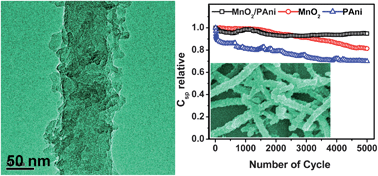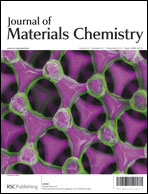Significant electrochemical stability of manganese dioxide/polyaniline coaxial nanowires by self-terminated double surfactant polymerization for pseudocapacitor electrode†
Abstract
Manganese dioxide/polyaniline coaxial nanowire networks are prepared by using double surfactant approach. This approach improves the interaction between the two active materials which has been confirmed by FTIR and XPS measurements, and yields a controllable uniform thin coating of polyaniline on the well-dispersed manganese dioxide nanowires. This hybrid heteronanostructure enhances the conductivity and capacitive performance of the supercapacitor electrode. The electrochemical test delivers specific capacitance as high as 498 and 873 F g−1 at 2 and 0.25 A g−1, respectively. Good cycling stability of up to 5000 cycles (5% capacitive degradation) outperforms other currently available redox nanocomposite electrodes. This result shows that the interaction among the active materials and improved nanostructure design are the two important factors to boost up the electrochemical performance of the hybrid nanomaterials. This work illustrates a promising platform that can be adopted for a myriad of metal oxide-conducting polymer nanocomposites while reaping the benefit as low cost electrode material for supercapacitor application.


 Please wait while we load your content...
Please wait while we load your content...